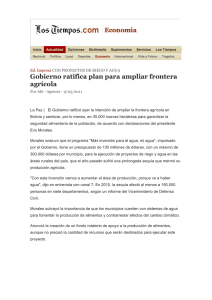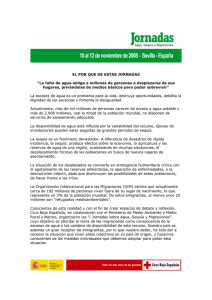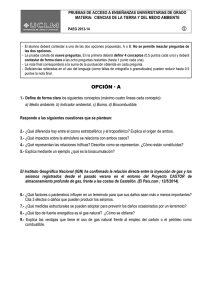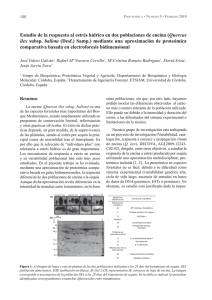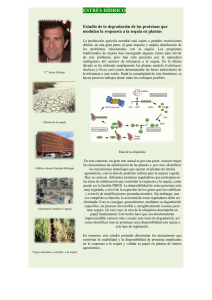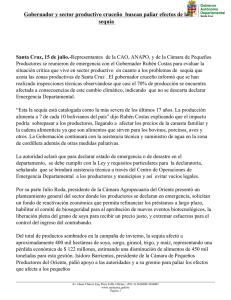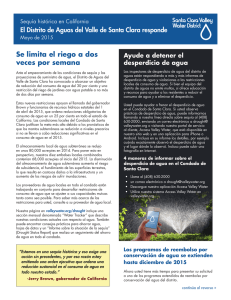Identificación de periodos de sequía histórica en una región de
Anuncio
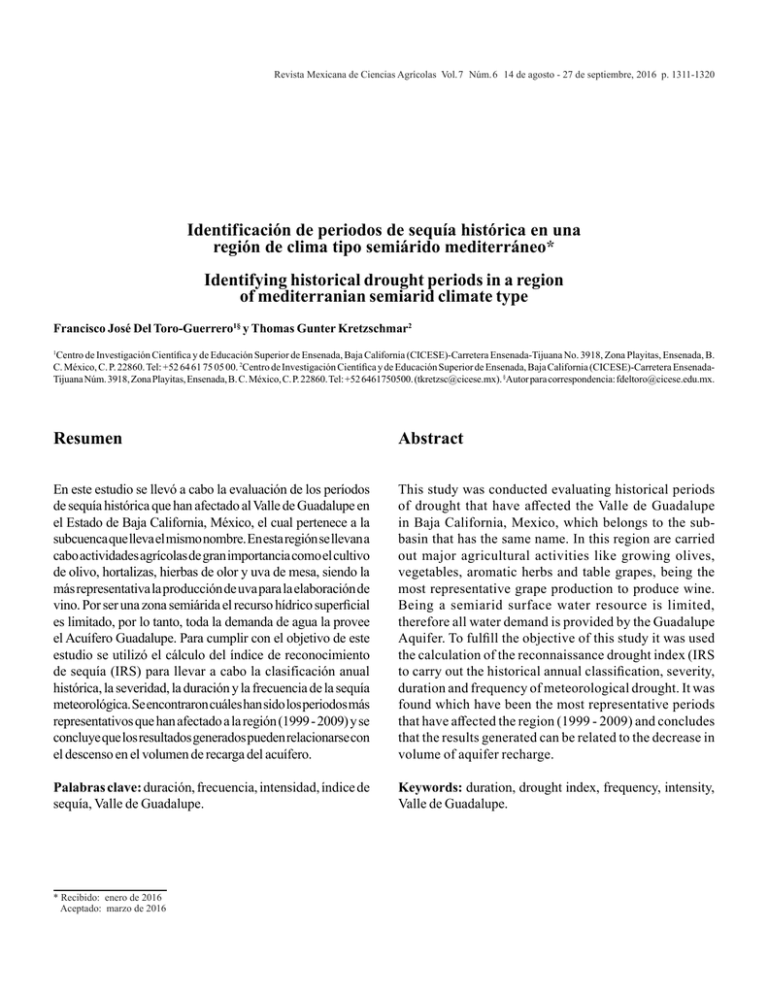
Revista Mexicana de Ciencias Agrícolas Vol.7 Núm.6 14 de agosto - 27 de septiembre, 2016 p. 1311-1320 Identificación de periodos de sequía histórica en una región de clima tipo semiárido mediterráneo* Identifying historical drought periods in a region of mediterranian semiarid climate type Francisco José Del Toro-Guerrero1§ y Thomas Gunter Kretzschmar2 Centro de Investigación Científica y de Educación Superior de Ensenada, Baja California (CICESE)-Carretera Ensenada-Tijuana No. 3918, Zona Playitas, Ensenada, B. C. México, C. P. 22860. Tel: +52 64 61 75 05 00. 2Centro de Investigación Científica y de Educación Superior de Ensenada, Baja California (CICESE)-Carretera EnsenadaTijuana Núm. 3918, Zona Playitas, Ensenada, B. C. México, C. P. 22860. Tel: +52 6461750500. ([email protected]). §Autor para correspondencia: [email protected]. 1 Resumen Abstract En este estudio se llevó a cabo la evaluación de los períodos de sequía histórica que han afectado al Valle de Guadalupe en el Estado de Baja California, México, el cual pertenece a la subcuenca que lleva el mismo nombre. En esta región se llevan a cabo actividades agrícolas de gran importancia como el cultivo de olivo, hortalizas, hierbas de olor y uva de mesa, siendo la más representativa la producción de uva para la elaboración de vino. Por ser una zona semiárida el recurso hídrico superficial es limitado, por lo tanto, toda la demanda de agua la provee el Acuífero Guadalupe. Para cumplir con el objetivo de este estudio se utilizó el cálculo del índice de reconocimiento de sequía (IRS) para llevar a cabo la clasificación anual histórica, la severidad, la duración y la frecuencia de la sequía meteorológica. Se encontraron cuáles han sido los periodos más representativos que han afectado a la región (1999 - 2009) y se concluye que los resultados generados pueden relacionarse con el descenso en el volumen de recarga del acuífero. This study was conducted evaluating historical periods of drought that have affected the Valle de Guadalupe in Baja California, Mexico, which belongs to the subbasin that has the same name. In this region are carried out major agricultural activities like growing olives, vegetables, aromatic herbs and table grapes, being the most representative grape production to produce wine. Being a semiarid surface water resource is limited, therefore all water demand is provided by the Guadalupe Aquifer. To fulfill the objective of this study it was used the calculation of the reconnaissance drought index (IRS to carry out the historical annual classification, severity, duration and frequency of meteorological drought. It was found which have been the most representative periods that have affected the region (1999 - 2009) and concludes that the results generated can be related to the decrease in volume of aquifer recharge. Palabras clave: duración, frecuencia, intensidad, índice de sequía, Valle de Guadalupe. Keywords: duration, drought index, frequency, intensity, Valle de Guadalupe. * Recibido: enero de 2016 Aceptado: marzo de 2016 1312 Rev. Mex. Cienc. Agríc. Vol.7 Núm. 6 14 de agosto - 27 de septiembre, 2016 Francisco José Del Toro-Guerrero y Thomas Gunter Kretzschmar Introducción Introduction El Valle de Guadalupe es un valle inter montano que tiene una superficie aproximada de 80 km2, superficie estimada considerando una pendiente > 5° que corresponde a la depresión de la subcuenca rellena de sedimentos aluviales donde se llevan a cabo extracciones de agua subterránea. Se localiza dentro de la subcuenca hidrográfica que lleva el mismo nombre en el noroeste del Estado de Baja California, México (Figura 1), entre los paralelos 32° 8’ 58” y 32° 0’ 10” de latitud norte y entre los meridianos 116° 41’ 25” y 116° 29’ 6” de longitud oeste. Con un tipo de clima semidesértico mediterráneo, en él se realizan diversas actividades agrícolas de gran importancia estatal, nacional y mundial donde destaca la viticultura (Kurczyn-Robledo, 2007). The Valle de Guadalupe is an inter montane valley that has an area of approximately 80 km2, surface estimated considering a slope > 5° which corresponds to the depression of the sub-basin filled with alluvial sediments where are carried out extractions of groundwater. It is located within the sub-basin of the same name in the northwestern state of Baja California, Mexico (Figure 1), between parallels 32° 8' 58" and 32° 0' 10" north latitude and between meridians 116° 41' 25" and 116° 29' 6" west longitude. With a mediterranean semi-desert climate, in this area various agricultural activities of great state, national and global importance are carried out in which viticulture stands out (Kurczyn-Robledo, 2007). La Comisión Nacional del Agua (CONAGUA, 2013), estimó que la temperatura y la precipitación media anual para la región son de 16.8°C y 295 mm, respectivamente, mientras que la evaporación potencial media anual se ha estimado en 1618 mm. La elevación del valle va de los 400 msnm en el límite noreste hasta los 300 msnm en el límite suroeste aproximadamente, rodeado por montañas con una altitud entre los 500 y 1400 msnm, cifras estimadas con un modelo digital de elevación de 30 m proporcionado por el Instituto Nacional de Estadística y Geografía (INEGI) obtenido de su página de libre acceso: http://www.inegi.org.mx/geo/ contenidos/datosrelieve/continental/descarga.aspx. The National Water Commission (CONAGUA, 2013) estimated that the temperature and average annual rainfall for the region is 16.8 °C and 295 mm, respectively, while average annual potential evaporation is estimated at 1 618 mm. The elevation of the valley ranges from 400 masl in the northeast limit to 300 masl on the southwestern border approximately, surrounded by mountains with an altitude between 500 and 1400 masl, estimated numbers with a digital elevation model of 30 m provided by the National Institute of Statistics and Geography (INEGI) obtained from its website: http://www.inegi.org.mx/geo/ contenidos/datosrelieve/continental/descarga.aspx. El principal uso del agua se destina para la agricultura, alcanzando el 72.6% principalmente para el cultivo de uva vinícola, 18.4% para uso público-urbano, 6% para uso doméstico, 1.2% para uso doméstico y agrícola, 0.9% para uso pecuario, 0.6% para uso agrícola e industrial y 0.3% para uso industrial (CONAGUA, 2013). El volumen total de extracción promedio entre 1990 y 2009 se estimó en 28.2 Mm3/año (CONAGUA, 2013). En la actualidad, el Acuífero Guadalupe es el único sustento para las actividades que se realizan en el valle y sus alrededores. Otro uso importante de este acuífero representa el abastecimiento de agua para la ciudad de Ensenada con un volumen autorizado de 6.9 Mm3, cifra calculada por la CONAGUA en el 2008. Actualmente se encuentra en estado de sobre-explotación, ya que presenta un déficit anual de ~12 Mm3, como resultado de una extracción mayor al nivel de recarga (CONAGUA, 2013), sumado a períodos de estiaje prolongados que ha presentado la región (CONAGUA, 2008). The main use of water is agriculture, reaching 72.6%, mainly to grow wine grapes, 18.4% for public-urban use, 6% for domestic use, 1.2% for domestic and agricultural use, 0.9% for livestock, 0.6% for agricultural and industrial use and 0.3% for industrial use (CONAGUA, 2013). The average total volume of extraction from 1990 and 2009 was estimated at 28.2 million m3/ year (CONAGUA, 2013). Currently, the Guadalupe Aquifer is the sole sustenance for activities that carried out in the valley and its surrounding areas. Another important use of this aquifer represents water supply for the city of Ensenada with an authorized volume of 6.9 Mm 3, calculated by CONAGUA in 2008. Currently is in overexploitation, as it presents an annual deficit of ~ 12 Mm3, as a result of increased extraction to the recharge level (CONAGUA, 2013), coupled with prolonged drought periods in the region (CONAGUA, 2008). Identificación de periodos de sequía histórica en una región de clima tipo semiárido mediterráneo 1313 La sequía se considera una amenaza natural que puede llegar a convertirse en un desastre si se prolonga durante largos períodos de tiempo, como resultado de un déficit en la precipitación. Conlleva a generar pérdidas económicas, a no satisfacer las necesidades humanas y del mismo entorno natural (Wilhite y Buchanan-Smith, 2005). Se debe considerar con un enfoque en tres dimensiones: de acuerdo a su gravedad, duración y superficie afectada (Tsakiris et al., 2007c). Drought is considered a natural hazard that can turn into a disaster if it lasts for long periods of time as a result of a deficit in precipitation; which can lead to economic losses, to not meet human and environmental needs (Wilhite and Buchanan-Smith, 2005). Consideration should be given with a focus on three dimensions: according to severity, duration and affected area (Tsakiris et al., 2007c). Existen diversas metodologías para la evaluación de la sequía, las cuales se pueden dividir en dos categorías: de acuerdo a las consecuencias del fenómeno y las que se apoyan en índices, combinando indicadores hidrológicos y climatológicos (Tsakiris y Pangalou, 2009). La primera puede ser útil para llevar a cabo un análisis de los episodios de sequía a lo largo de la historia; la segunda permite evaluar y caracterizar a la sequía en el presente utilizando índices (Tsakiris y Pangalou, 2009), los cuales se calculan a partir de la información climatológica de la región de interés. Al interrelacionar los parámetros vinculados con el clima, los índices de sequía evalúan cuantitativamente las anomalías climáticas como su intensidad, duración, frecuencia y extensión territorial (Wilhite et al., 2000). Cuando la información climatológica está disponible, se puede analizar la ocurrencia histórica y la probabilidad de recurrencia, lo que permite llevar a cabo una planificación y administración de los recursos hídricos (Tsakiris et al., 2007b). There are several methodologies to evaluate drought, which can be divided into two categories according to the consequences of the phenomenon and that rely on indexes, combining hydrological and climatological indicators (Tsakiris and Pangalou, 2009). The first may be useful to carry out an analysis of drought events throughout history; the second allows to evaluate and characterize current drought using indices (Tsakiris and Pangalou, 2009), which are calculated from climatological information of the region of interest. To interrelate parameters link to climate, drought indices quantitatively assess climate anomalies and their intensity, duration, frequency and territorial extension (Wilhite et al., 2000). When climatological information is available, it can be analyzed the historical occurrence and likelihood of recurrence, which allows planning and management of water resources (Tsakiris et al., 2007b). Por lo mencionado anteriormente, el Valle de Guadalupe y su acuífero tienen gran relevancia en la región en una perspectiva biológica, económica y humana. El documentar los periodos de estiaje históricos, podría permitir relacionar la ocurrencia del fenómeno climatológico con un déficit en el volumen de recarga natural hacia el acuífero (Figura 1). By the above, the Guadalupe Valley and its aquifer have great relevance in the region from a biological, economic and human perspective. Documenting historical periods of low water, could allow relating the occurrence of weather phenomenon with a deficit in the volume of natural recharge to the aquifer (Figure 1). Generar estrategias para la optimización, conservación, aprovechamiento y el manejo estratégico del agua es prioritario en la región. En este contexto, el objetivo principal del estudio fue llevar a cabo una descripción y análisis sobre la frecuencia, duración y severidad de la sequía climatológica en el Valle de Guadalupe. El IRS es un método estadístico que permite llevar a cabo una descripción de las condiciones de sequía, la serie de datos climatológicos históricos son necesarios para llevar a cabo la estimación. Mismos que se obtuvieron de los registros de las estaciones climáticas de la CONAGUA. Los estudios de identificación de los periodos de sequía histórica en la región son escasos, por lo que este trabajo contribuye a generar información sobre las condiciones actuales del fenómeno. Generate strategies to optimize, conserve, use and strategic water management is a priority in the region. In this context, the main objective of the study was to carry out a description and analysis on the frequency, duration and severity of climatological drought in Valle de Guadalupe. IRS is a statistical method that allows performing a description of drought conditions, the series of historical climatological data are necessary to carry out the estimate. Same that was obtained from records of weather stations of CONAGUA. The studies to identify periods of historic drought in the region are scarce, so this work contributes to the current conditions of the phenomenon. 1314 Rev. Mex. Cienc. Agríc. Vol.7 Núm. 6 14 de agosto - 27 de septiembre, 2016 Francisco José Del Toro-Guerrero y Thomas Gunter Kretzschmar Materiales y métodos Cálculo del índice de reconocimiento de sequía (IRS) El cálculo del IRS se basa en la relación entre la precipitación (P) y la evapotranspiración potencial (ETP). El valor inicial del índice para un cierto período de tiempo comienza con el primer mes del año hidrológico (k) y durante ese año, a partir de la siguiente ecuación (Tsakiris y Vangelis, 2005): j=k Σj=i Pj a = k j=k Σj=i ETPJ 1) Donde: ak= representa el valor inicial del IRS y Pj y ETPJ= es la precipitación y la evapotranspiración potencial del mes j del año hidrológico, respectivamente. En esta región, la P se presenta en invierno, mientras que los veranos son generalmente secos por lo que en diversos trabajos de investigación se ha señalado el comienzo del año hidrológico en el mes de octubre (Campos- Gaytán, 2008, Barrandas- Argüelles, 2010 y Del Toro-Guerrero, 2014). El valor medio inicial del IRS concuerda con el índice de aridez propuesto por la Organización de las Naciones Unidas para la Alimentación y la Agrigultura (FAO, por sus siglas en inglés) para la evaluación de la aridez de un área determinada (Tsakiris et al., 2007c). El IRS normalizado (IRSn) se calcula utilizando la siguiente ecuación para cada año de la serie de tiempo (Tsakiris et al., 2007b): ak -1 IRS n= āk 2) Donde: āk= simboliza a la media aritmética de ak; una tercera ecuación representa al IRS estandarizado (IRSstd), la cual se calcula a partir de la siguiente expresión (Tsakiris et al., 2007b): y k - ȳk IRSstd= dsk 3) Donde: yk = Significa el ln (ak); ȳk = Representa a la media aritmética; y dsk= Es su desviación estándar. En su comportamiento el IRSstd tiene gran similitud al índice estandarizado de precipitación (IEP) (Tsakiris y Pangalou, 2009), por lo que la interpretación de los resultados se ajusta a la siguiente tabla (Cuadro 1). Figura 1. Hidrografía de la región, localización del área de estudio y de las estaciones climatológicas de la CONAGUA evaluadas y seleccionadas en este trabajo. Figure 1. Hydrography of the region, location of study area and weather stations from CONAGUA evaluated and selected in this work. Materials and methods Calculation of drought recognition rate (IRS) IRS calculation is based on the relationship between precipitation (P) and potential evapotranspiration (ETP). The initial value of the index for a certain period of time begins with the first month of hydrological year (k) and during that year, from the following equation (Tsakiris and Vangelis, 2005): j=k Σj=i Pj a = k j=k Σj=i ETPJ 1) Where: k= represents the initial value of IRS and Pj and ETPJ= is the precipitation and potential evapotranspiration from month j of the hydrological year, respectively. In this region, P occurs in winter, while summers are usually dry so in several research papers has been noted the beginning of the hydrological year in October (Campos Gaytan, 2008, Barrandas- Argüelles, 2010 and Del Toro-Guerrero, 2014). The average initial value of IRS agrees with the aridity index proposed by the Food andAgriculture Organization of the United Nations to assess aridity of a given area (Tsakiris et al., 2007c). Identificación de periodos de sequía histórica en una región de clima tipo semiárido mediterráneo 1315 Asimismo, Tikgas (2008), consideró que los valores correspondientes que van de 0 a 0.99 se pueden establecer como una condición normal-húmeda, mientras que los valores que van de 0 a -0.50 también pueden considerarse dentro del parámetro normal-seco. Normalized IRS (IRSn) is calculated using the following equation for each year of the time series (Tsakiris et al., 2007b): Procesamiento de datos y estaciones climatológicas Where: āk= symbolizes the arithmetic mean of ak; a third equation represents standardized IRS (IRSstd), which is calculated from the following expression (Tsakiris et al., 2007b): La estimación del IRS puede ser complejo ya que involucra la evaluación de la distribución espacial de los indicadores o variables ambientales (precipitación, temperatura y evapotranspiración potencial) (Tsakiris et al., 2007c). El programa drinc (calculador de índice de sequía), fue diseñado para facilitar el cálculo de la ETP a través del método de Thornthwaite y del IRS, al utilizar los datos de ETP y P de alguna estación climatológica. Este programa fue desarrollado por el laboratorio de obras de recuperación y gestión de los recursos hídricos de la universidad nacional técnica de Atenas (Tsakiris et al., 2007c). La versión en línea del programa puede encontrarse en: www.ewra.net/drinc (Tigkas, 2008). La red de estaciones climatológicas en el noroeste de México es extensa, sin embargo la mayor parte de la información contiene series de tiempo discontinuas, valores perdidos o no registrados, por lo tanto se torna difícil empatar una misma serie de datos entre dos o más estaciones. En este estudio se evaluaron los datos meteorológicos de ocho estaciones climatológicas de la CONAGUA (Cuadro 2). Se localizan dentro de la Cuenca Guadalupe (Figura 1), sin embargo la mayoría de ellas tienen series de datos discontinuos y la distancia entre las estaciones y la zona de interés es mayor a su área de influencia, la cual es de ~5 km de radio según la Organización Meteorológica Mundial, cuando la topografía es plana (OMM, 2011) (Figura 1). Solo las estaciones de El Porvenir y Agua Caliente cumplieron con los criterios necesarios para llevar a cabo el trabajo de investigación, los cuales son: tener una serie de datos continuos (o lo más completa posible para evitar errores al estimar datos faltantes) y que el área de influencia climatológica corresponda con la zona de estudio. Ambas cuentan con una serie de datos de 22 y más de 30 años respectivamente de información climatológica parcialmente continua. La estimación de los datos faltantes se llevó a cabo con el método del Servicio Nacional de Meteorología de Estados Unidos (U.S. National Weather Service) descrito por Campos-Aranda (1992), el cual considera que el dato puede ser aproximado con base en la información estimada en las estaciones circundantes (Ecuación 4). ak IRSn= -1 āk y k - ȳk IRSstd= dsk 2) 3) Where: yk= means ln (ak); ȳk= represents the arithmetic mean; and dsk= is the standard deviation. In its behavior IRSstd has great similarity to the standardized precipitation index (IEP) (Tsakiris and Pangalou, 2009), so that the interpretation of the results fits to the following table (Table 1). Cuadro 1. Clasificación de la sequía de acuerdo al valor de IEP y las probabilidades de ocurrencia. (Tsakirys et al., 2007c). Table 1. Classification of drought according to IEP value and probabilities of occurrence (Tsakirys et al., 2007c). Valor IEP Categoría Probabilidad (%) 2 o más Extremadamente húmedo 2.3 1.5 a 1.99 Severamente húmedo 4.4 1 a 1.49 Moderadamente húmedo 9.2 0 a 0.99 Ligeramente húmedo 34.1 0 a -0.99 Sequía leve 34.1 -1 a -1.49 Sequía moderada 9.2 -1.5 a -1.99 Sequía severa 4.4 -2 o menos Sequía extrema 2.3 Tikgas (2008) also found that the corresponding values ranging from 0 to 0.99 can be set as a normal-wet condition, while values ranging from 0 to -0.50 can also be considered within the normal-dry setting. Data processing and weather stations IRS estimates can be complex because it involves the evaluation of spatial distribution of indicators or environmental variables (precipitation, temperature and potential evapotranspiration) (Tsakiris et al., 2007c). The Francisco José Del Toro-Guerrero y Thomas Gunter Kretzschmar 1316 Rev. Mex. Cienc. Agríc. Vol.7 Núm. 6 14 de agosto - 27 de septiembre, 2016 P= Σ(Pi * Wi)/ ΣWi Drinc program (drought index calculator), was designed to facilitate ETP calculation through Thornthwaite and IRS method, using ETP and P data from some weather station. This program was developed by the laboratory of reclamation works and water resources management from the National Technical University of Athens (Tsakiris et al., 2007c). The online version of the program can be found at: www.ewra.net/drinc (Tigkas, 2008). The network of weather stations in northwestern Mexico is large, however most of the information contains series of discontinuous 4) Donde: P= dato faltante en mm o °C; Pi= precipitación o temperatura observada para el mes del dato faltante en las estaciones auxiliares en mm o °C; y Wi = 1/Di2. Donde: Di representa a las distancias entre las estaciones auxiliares y la estación incompleta en km. Los datos de precipitación y evapotranspiración potencial se aprecian en la Figura 2. Cuadro 2. Estaciones climatológicas de la CONAGUA evaluadas en este estudio. La elevación está en metros sobre el nivel del mar. Table 2. Weather stations evaluated from CONAGUA in this study. The elevation is in meters above sea level. Estación Olivares Mexicanos El Pinal El Compadre Valle de San Rafael Real del Castillo Viejo Valle de La Misión Agua Caliente El Porvenir Longitud -116.6012 -116.2847 -116.25 -116.2053 -116.3487 -116.81 -116.4639 -116.6332 Estación climatológica Agua Caliente (CONAGUA) Serie de datos 1954 - 2008 1969 - 1999 1948 - 1960 1979 - 2012 1980 - 1989 2000 - 2013 1978 - 2013 1991 - 2013 Datos faltantes Sí Sí No No Sí No No No Estación climatológica El Porvenir (CONAGUA) 1000 900 1000 800 900 800 P y ETP (mm) 700 600 500 400 700 600 500 400 Serie de tiempo - Año hidrológico (1979 - 2013) 2013 2011 Serie de tiempo - Año hidrológico (1979 - 2013) 2012 2010 2009 2008 2007 2006 2005 2004 2003 2002 2001 2000 1999 1998 0 1997 0 1996 100 1995 200 100 1979 1980 1981 1982 1983 1984 1985 1986 1987 1988 1989 1990 1991 1992 1993 1994 1995 1996 1997 1998 1999 2000 2001 2002 2003 2004 2005 2006 2007 2008 2009 2010 2011 2012 2013 200 1994 300 300 1993 P y ETP (mm) Elevación 364 1291 1162 750 644 0 410 318 1992 1200 1100 Latitud 32.0357 32.1992 32.15 31.9094 32.0026 32.1022 32.1124 32.0738 Figura 2. Valores de P y ETP anual en mm de las estaciones climatológicas de la CONAGUA en su respectiva serie de tiempo. La línea inferior representa el valor promedio histórico de la P de las estaciones Agua Caliente (278 mm/año) y El Porvenir (342 mm/año). La superior representa el valor promedio histórico de la ETP de las estaciones Agua Caliente (890 mm/año) y El Porvenir (830 mm/año). Figure 2. Annual values of P and ETP in mm of weather stations from CONAGUA in their respective time series; the bottom line represents the average historical value of P from the weather stations Agua Caliente (278 mm/year) and El Porvenir (342 mm/year). The top represents the average historical value of ETP from weather stations Agua Caliente (890 mm/year) and El Porvenir (830 mm/year). Identificación de periodos de sequía histórica en una región de clima tipo semiárido mediterráneo Resultados y discusión Análisis temporal e identificación de los períodos de sequía Los valores del IRS se estimaron con los resultados de los datos climáticos de las estaciones, representados en la Figura 3. En la porción noreste del Valle de Guadalupe, donde se encuentra la estación Agua Caliente se observó una sequía persistente que duró 10 años (1999-2009), durante este período sólo el año hidrológico 2005 fue clasificado como moderadamente húmedo. Los demás años hidrológicos se clasificaron con sequía leve (1999, 2000, 2003, 2004, 2008 y 2009), sequía moderada (2006), sequía severa (2007) y sequía extrema (2002). Se observaron otros periodos de sequía en los años hidrológicos 1989 y 1990, siendo clasificados con sequía severa y moderada respectivamente. En la zona central del Valle de Guadalupe, en la estación El Porvenir se observó una sequía con una duración de 4 años (2005-2009). Durante este período los años hidrológicos con sequía fueron clasificados con sequía leve (2008 y 2009), sequía moderada (2006) y sequía severa (2007). Además se observó otro evento representativo durante el período (19992002), solamente el año hidrológico 2001 fue ligeramente húmedo. El año 1999 se clasificó con sequía leve, 2000 con sequía moderada y 2002 con sequía severa (Figura 3). Las sequías severas y extremas coinciden en los mismos períodos para ambas estaciones (2001-2002 y 2006-2007), y figuran como los años hidrológicos con menor precipitación en la serie de tiempo. En la estación Agua Caliente, por tener una serie de datos mayor es más evidente observar con el paso del tiempo el aumento de los años hidrológicos donde la P anual es menor a la media (Figura 2). Entre 1979 y 1995, ocho años hidrológicos presentaron esta condición, mientras que, entre 1996 y 2013, catorce años hidrológicos exhibieron una P menor a la media anual. Este escenario puede ser un indicador de un cambio en la climatología regional. Al relacionar lo mencionado anteriormente con los resultados reflejados en la Figura 3, se aprecia que los años en los que se documenta que la P es menor a la media anual coinciden con los periodos de sequía. Así mismo, en la mayoría de los casos se podría clasificar a un año hidrológico como seco cuando se presenta esta condición (Figura 2 y 3) y mientras menor sea la P durante dicho año hidrológico, la intensidad de la sequía aumenta (Figura 3). 1317 time, missing values or not recorded, therefore it becomes difficult to draw the same set of data between two or more stations. In this study the meteorological data of eight weather stations from CONAGUA (Table 2) were evaluated. These are located within the Guadalupe basin (Figure 1), however most of them have series of discontinuous data and the distance between the stations and the area of interest is greater than its area of influence, which is ~ 5 km radius according to the World Meteorological Organization, when topography is flat (WMO, 2011) (Figure 1). Only stations from El Porvenir and Agua Caliente met the criteria necessary to carry out the research work, which are: to have a series of continuous data (or as complete as possible to avoid errors in estimating missing data) and the climatological influence area corresponds to the area of study. Both have a data set of 22 and over 30 year respectively of partially continuous climatological information. The estimation of missing data was carried out with the method from the US National Weather Service described by Campos-Aranda (1992), which considers that the data can be approximate based on information estimated in the surrounding stations (Equation 4). P= Σ(Pi * Wi)/ ΣWi 4) Where: P= missing data in mm or °C; Pi= precipitation or temperature observed for the month of the missing data in auxiliary stations in mm or °C; and Wi= 1/Di2. Where: Di represents the distance between the auxiliary stations and incomplete station in km. Precipitation and potential evapotranspiration data is appreciated in Figure 2. Results and discussion Weather analysis and identification of drought periods IRS values were estimated with the results from weather station data, shown in Figure 3. In the northeastern portion of the Guadalupe Valley, where the station Agua Caliente is, it was observed a persistent drought that lasted 10 years (1999 -2009), during this period only the hydrological year 2005 was classified as moderately moist. Other hydrological years were classified with mild drought (1999, 2000, 2003, Francisco José Del Toro-Guerrero y Thomas Gunter Kretzschmar 1318 Rev. Mex. Cienc. Agríc. Vol.7 Núm. 6 14 de agosto - 27 de septiembre, 2016 Estación climatológica Agua Caliente (CONAGUA) 2 600 2 700 600 1 500 Serie de tiempo - Año hidrológico (1979 - 2013) 0 2013 2011 2012 2010 2009 2008 2007 2006 2005 2004 2003 2002 2001 2000 1999 -3 1998 0 1997 -3 100 1996 100 1979 1980 1981 1982 1983 1984 1985 1986 1987 1988 1989 1990 1991 1992 1993 1994 1995 1996 1997 1998 1999 2000 2001 2002 2003 2004 2005 2006 2007 2008 2009 2010 2011 2012 2013 -2 200 -2 1995 200 1994 -1 300 -1 1993 300 400 1992 0 0 Precipitación (mm) 400 500 Precipitación (mm) 1 Valores IRS Estación climatológica El Porvenir (CONAGUA) 700 Valores IRS 3 Serie de tiempo - Año hidrológico (1979 - 2013) Figura 3. Valores del IRS (barras) y la P media anual (línea sólida con marcas), donde se diferencian los años húmedos de los secos separados por el valor de la P media anual histórica (línea con espacios) y los períodos de sequía de las estaciones Agua Caliente y El Porvenir. Figure 3. IRS (bars) values and average annual P (solid line with marks), where moist years differentiate from dry years separated by the value of the annual average historical P (line with spaces) and drought periods from Agua Caliente and El Porvenir stations. Otros aspectos importantes para valorar son la duración y la frecuencia de la sequía. Se ha visto que incluso las sequías moderadas pueden causar problemas mayores si persisten durante varios años (Tigkas, 2008). Las regiones áridas y semiáridas pueden ser vulnerables ante estas características ya que el volumen de precipitación anual tiende a ser limitado. La severidad de la sequía en la región del Valle de Guadalupe tiene una relación directa con el volumen reducido de la precipitación (Figura 3); sin embargo, las sequías severas y extremas han sido poco frecuentes (8.5% Agua Caliente y 9% El Porvenir) con respecto a su correspondiente serie de tiempo de análisis. Mientras que la frecuencia y la duración han tenido una gran relevancia en la región al analizar la sequía. Con una duración aproximada de 10 años, el período más representativo (1999-2009) y algunos otros episodios a lo largo del estudio. El Programa Hidráulico Regional 20032006, refiere que el acuífero estaba catalogado con una condición de sub explotación, ya que el volumen de recarga se estimó en 24 Mm3/año y una extracción de 22 Mm3/ año (Kurczyn-Robledo, 2007). En 2009, la CONAGUA reportó un déficit de 19 Mm3/año, esto quiere decir que en tan sólo tres años el manto acuífero pasó de estar clasificado como sub explotado a sobre explotado. En 2013, la misma institución estimó un déficit de 12 Mm3/año que se extraen 2004, 2008 and 2009), moderate drought (2006), severe drought (2007) and extreme drought (2002). Other periods of drought were observed in hydrological years 1989 and 1990, being classified with severe and moderate drought respectively. In the central area from Guadalupe Valley, El Porvenir station was observed a drought lasting 4 years (2005-2009). During this period hydrological drought years were classified with mild drought (2008 and 2009), moderate drought (2006) and severe drought (2007). In addition another representative event was observed during the period (1999-2002), only the hydrological year 2001 was slightly damp. 1999 was classified with mild drought, 2000 moderate drought and 2002 severe drought (Figure 3). Severe and extreme drought coincide in the same periods for both seasons (2001-2002 and 2006-2007), and listed as hydrological years with less precipitation in the time series. Agua Caliente station, by having a greater number of data is more evident to observe over time increased hydrologic years where annual P is smaller than average (Figure 2). Between 1979 and 1995 eight hydrological years showed this condition, while between 1996 and 2013, fourteen hydrological years exhibited a P lower than annual average. This scenario can be an indicator of a change in regional Identificación de periodos de sequía histórica en una región de clima tipo semiárido mediterráneo del almacenamiento no renovable del acuífero, por lo tanto el acuífero en la actualidad aún se considera en estado de sobre explotación. Conclusiones El índice IRS caracteriza adecuadamente la severidad, la duración y la frecuencia de la sequía, además esta metodología es una herramienta práctica y adecuada para descripción del fenómeno en el pasado y proporciona información relevante sobre las condiciones de estiaje actuales permitiendo generar estrategias para el manejo y su prevención. El análisis de identificación de sequía, utilizando el índice IRS en combinación con los datos de precipitación histórica anual pueden definir y describir el fenómeno en la región del Valle de Guadalupe y los resultados generados, pueden relacionarse con el descenso en el volumen de almacenamiento de agua subterránea en el Acuífero Guadalupe desde el punto de vista climatológico. 1319 climate. By relating the above with the results shown in Figure 3, can be seen that the years in which it is documented that the P is lower than the annual average coincide with drought periods. Also, in most cases it could be classified to a hydrological year as dry when this condition is present (Figure 2 and 3) and as lower P is during the hydrological year, drought intensity increases (Figure 3). Other important aspects to assess are drought duration and frequency. It has been seen that even moderate droughts can cause major problems if it persist for several years (Tigkas, 2008). Arid and semiarid regions may be vulnerable to these characteristics because the annual volume rainfall tends to be limited. Drought severity in the Guadalupe Valley region has a direct relationship with the reduced volume of precipitation (Figure 3); however, severe and extreme droughts have been rare (8.5% Agua Caliente and 9% El Porvenir) with respect to the corresponding time series analysis. While frequency and duration have had great importance in the region by analyzing drought. En el presente trabajo, los autores expresan su agradecimiento al Fondo Institucional de Fomento Regional para el Desarrollo Científico, Tecnológico y de Innovación (FORDECYT) con número de proyecto 146606 y al Centro de Investigación Científica y de Educación Superior de Ensenada, Baja California (CICESE) por el apoyo recibido. With an approximate duration of 10 years, the most representative period (1999-2009) and some other events throughout the study. The Regional Hydraulic Program 20032006, states that the aquifer was listed with a status of sub exploitation, because the volume of recharge was estimated at 24 million m3/year and an extraction of 22 million m3/ year (Kurczyn-Robledo, 2007). In 2009, the National Water Commission reported a deficit of 19 million m3/year, this means that in just three years the aquifer went from being classified as sub exploited to overexploit. In 2013, the same institution estimated a deficit of 12 million m3/year which are extracted from non-renewable aquifer storage, so until today the aquifer is still considered in a status of overexploitation. Literatura citada Conclusions Barrandas, A. M. R. 2010. Cambios hidrológicos en las cuencas que abastecen de agua a la zona de Ensenada, Baja California, México. Tesis de Maestría. Centro de Investigación Científica y de Educación Superior de Ensenada (CICESE). Ensenada, B.C. México. 66 p. Campos, A. D. F. 1992. Procesos del ciclo hidrológico. Segunda reimpresión. Universidad Autónoma de San Luis Potosí. México. Campos, G. J. R. 2008. Simulación del flujo de agua subterránea en el acuífero del Valle de Guadalupe, Baja California, México. Tesis de doctorado. Centro de Investigación Científica y de Educación Superior de Ensenada (CICESE). Ensenada, B. C. México. 220 p. The IRS index adequately characterizes the severity, duration and frequency of drought, in addition this methodology is a practical and appropriate tool for description of the phenomenon in the past and provides relevant information on current conditions of dry season allowing to generate management strategies and prevention. Agradecimientos Identification analysis of drought, using IRS index in combination with data from historical annual precipitation can define and describe the phenomenon in the region of 1320 Rev. Mex. Cienc. Agríc. Vol.7 Núm. 6 14 de agosto - 27 de septiembre, 2016 CONAGUA. 2008. Plan maestro de manejo del Acuífero Guadalupe, Municipio de Ensenada, B.C. Tomo III. Informe técnico. Ensenada, B. C. México. 111 p. CONAGUA. 2009. Determinación de la disponibilidad de agua en el Acuífero Guadalupe (0207). Estado de Baja California. Subdirección General Técnica. Gerencia deAguas Subterráneas. Subgerencia de Evaluación y Ordenamiento de Acuíferos. México. Publicado en el Diario Oficial de la Federación. 21 p. CONAGUA. 2013. Determinación de la disponibilidad de agua en el Acuífero Guadalupe (0207). Estado de Baja California. Subdirección General Técnica. Gerencia deAguas Subterráneas. Subgerencia de Evaluación y Ordenamiento de Acuíferos. México. Publicado en el Diario Oficial de la Federación. 31 p. Del Toro, G. F. J.; Kretzschmar, T. e Hinojosa, C. A. 2014. Estimación del balance hídrico en una cuenca semiárida, El Mogor, Baja California, México. México. Tecnología y Ciencias del Agua. 6(5):69-81. Kurczyn, R. A.; Kretzschmar, T. e Hinojosa, C. A. 2007. Evaluación del escurrimiento superficial en el noroeste del Valle de Guadalupe, B. C. México, usando el método de curvas numeradas y datos de satélite. México. Rev. Mex. Cienc. Geol. 24(1):1-14. Tigkas, D. 2008. Drought characterization and monitoring in regions of Greece. Greece. European Water. 23(24):29-39. OMM. 2011. Guía de prácticas climatológicas. Organización Meteorológica Mundial. 100. Ginebra, Suiza. 128 p. Tsakiris, G. and Vangelis, H. 2005. Establishing a drought index incorporating evapotranspiration. European Water. 9-10:1-9. Tsakiris, G.; Pangalou, D. and Vangelis, H. 2007b. Regional drought assessment based on the reconnaissance drought index (RDI). Water Res. Manag. 21(5):821-833. Francisco José Del Toro-Guerrero y Thomas Gunter Kretzschmar Guadalupe Valley and the results generated can be related to the decrease in the volume of water storage underground in the Guadalupe Aquifer from the climatological point of view. End of the English version Tsakiris, G.; Tigkas, D.; Vangelis, H. and Pangalou, D. 2007c. regional drought identification and assessment - case study in Crete. In: methods and tools for drought analysis and management, Rossi, L. (Eds.). Springer, The Netherlands. 169-191 pp. Tsakiris, G. and Pangalou, D. 2009. Drought Characterisation in the Mediterranean. In: Iglesias, A.; Garrote, L. and Concelliere, A. (Eds). Coping with drought risk in agriculture and water supply. Advances in natural and technological hazards research. Springer, New York. 69-80 pp. Wilhite, D. A.; Hayes, M. J. and Svodoba, M. D. 2000. Drought monitoring and assessment: status and trends in the United States. The Netherlands. Drought and Drought Mitigation in Europe. Advances in Natural and Technological Hazards Research. (14):149-160. Wilhite, D. A. and Buchanan, S. M. 2005. Drought as a Hazard: undestanding the natural and social context. In: Wilhite, D. (Ed.). Drought and water crisis science. Technology and Management Issues. 3-32 pp.
